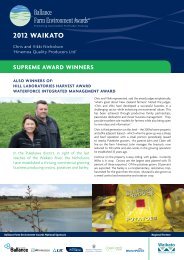Dairy's role in sustaining New Zealand - Fonterra
Dairy's role in sustaining New Zealand - Fonterra
Dairy's role in sustaining New Zealand - Fonterra
Create successful ePaper yourself
Turn your PDF publications into a flip-book with our unique Google optimized e-Paper software.
Key po<strong>in</strong>ts<br />
Dairy makes a very strong direct contribution to the NZ economy<br />
• The dairy sector directly accounts for 2.8% of GDP, or $5 billion. This contribution is:<br />
o greater than the GDP contribution of the fish<strong>in</strong>g, forestry and m<strong>in</strong><strong>in</strong>g sectors<br />
comb<strong>in</strong>ed<br />
o around 10 times as large as the GDP of the w<strong>in</strong>e sector<br />
o about 3 times as large as the forestry and logg<strong>in</strong>g sector<br />
o over a third of the GDP contribution of the entire primary sector (dairy and meat<br />
farm<strong>in</strong>g and process<strong>in</strong>g, horticulture, fish<strong>in</strong>g, forestry, m<strong>in</strong><strong>in</strong>g)<br />
o 40% larger than the entire utilities sector (electricity, gas and water)<br />
o 2/3 as large as the entire construction sector<br />
o 15% of the total GDP of the goods produc<strong>in</strong>g <strong>in</strong>dustries and<br />
o provides 26% of <strong>New</strong> <strong>Zealand</strong>’s total goods exports.<br />
And contributes to the health of the NZ economy <strong>in</strong> many ways<br />
• But the sector’s <strong>in</strong>fluence extends well beyond its direct impacts. Dairy is closely<br />
<strong>in</strong>tertw<strong>in</strong>ed with the rest of the economy. This <strong>in</strong>cludes the jobs it delivers, the <strong>in</strong>come<br />
that these workers earn, its l<strong>in</strong>ks to supply<strong>in</strong>g firms, the effects of rural economic growth<br />
on urban centres, the tax revenue it provides and the public services that can be funded<br />
from this tax revenue. These l<strong>in</strong>ks are shown <strong>in</strong> the figure at the end of this section.<br />
• Of the $10.4 billion of dairy products exported <strong>in</strong> 2009,<br />
o $7.5 billion is used to purchase raw milk from the dairy farm<strong>in</strong>g sector.<br />
o $1.5 billion is reta<strong>in</strong>ed as returns to labour and capital (i.e. wages and rate of return).<br />
o $625 million is spent on <strong>in</strong>termediate <strong>in</strong>puts from <strong>New</strong> <strong>Zealand</strong>. This <strong>in</strong>cludes $85<br />
million of plastic conta<strong>in</strong>ers, $45 million on electricity and $22.5 million on f<strong>in</strong>ancial<br />
services.<br />
o Imported <strong>in</strong>termediate <strong>in</strong>puts account for $310 million – largely plastic conta<strong>in</strong>ers<br />
($182 million) and other food products to be used <strong>in</strong> process<strong>in</strong>g ($30 million).<br />
o $730 million is spent on retail<strong>in</strong>g/wholesal<strong>in</strong>g costs that get the dairy products from<br />
the plant to market.<br />
• Of the $7.5 billion value of raw milk output, $3.0 billion is reta<strong>in</strong>ed as returns to land,<br />
labour and capital. A further $3.6 billion is spent on domestically produced <strong>in</strong>termediate<br />
<strong>in</strong>puts, such as fertilizer ($447 million), feed ($723 million), agricultural services ($446<br />
million), f<strong>in</strong>ancial services<br />
Dairy’s <strong>role</strong> <strong>in</strong> generat<strong>in</strong>g growth<br />
C
















